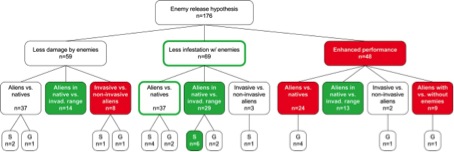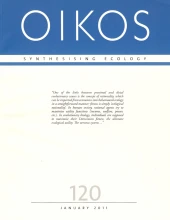Ecological synthesis is tricky. One of its many challenges is that empirical data rarely paint a clear picture either supporting or refuting a given hypothesis. More typically, empirical studies have diverging results. But even for hypotheses where refuting evidence is overwhelming, ecologists are often reluctant to abandon them (see Oikos Blog on Zombie Ideas).
In our paper “The enemy release hypothesis as a hierarchy of hypotheses” (Heger & Jeschke in Oikos, early view), we explore a novel method for assessing ecological hypotheses based on empirical evidence: the Hierarchy-of-Hypotheses (HoH) approach. This approach was born during a joint project (see Jeschke et al. 2012 in Neobiota) and a workshop titled ‘‘Tackling the emerging crisis of invasion biology: How can ecological theory, experiments, and field studies be combined to achieve major progress?’’ (see Heger et al. 2013 in Ambio). When we discussed the problem of imprecise formulations of hypotheses in invasion ecology (another challenge to ecological synthesis), it became obvious that we need a framework for integrating both broad and narrow hypotheses. Our suggestion for such a framework is the HoH approach, where a broad, overarching hypothesis branches into increasingly narrow and specific formulations of this hypothesis (i.e. sub-hypotheses). The most specific formulations are empirically testable.
The HoH approach can serve as an organizational tool (e.g. to structure research questions, or to organize conceptual work), but also for assessing hypotheses. In our paper, we show the first worked-out example for a HoH. We used the method for a well-known and much discussed hypothesis of invasion ecology: the enemy release hypothesis. Applying a newly developed weighting procedure, we assessed empirical evidence for each sub-hypothesis. Our results show that overall, there is nearly as much evidence in favor as against the enemy release hypothesis; hence, the overall picture is quite blurry. However, a closer look at the sub-hypotheses reveals that specific formulations of the enemy release hypothesis are clearly empirically supported, whereas other formulations receive hardly any support (see Fig. 1). This example shows how powerful the HoH approach can be to make a blurry picture clear.
Figure 1. Schematic illustration of a hierarchy of hypotheses (HoH) for the enemy release hypothesis. The scheme classifies empirical tests of the enemy release hypothesis according to three criteria, shown as three hierarchical levels: (1) indicator for enemy release; (2) type of comparison; and (3) type of enemies. The combination of these criteria results in different sub-hypotheses which are drawn as boxes; the number of empirical tests available for each sub-hypothesis is given in the respective box (‘n’). The boxes are color-coded as follows: red boxes: 50% or more of the data question the sub-hypothesis, and n≥5; green boxes: 50% or more of the data support the sub-hypothesis, and n≥5; white boxes: all other cases (i.e. n<5 or inconclusive data).
In writing the paper, we had several discussions on how much empirical support is needed to call a hypothesis ‘supported’. For Fig. 1, we agreed on the threshold of 50% support, but this is debatable. We believe that ecology needs a discussion on these questions: How do we decide whether a hypothesis is worth keeping? How much supporting evidence is needed, and how much refuting evidence can be tolerated? We very much hope that our paper stimulates discussions on these and similar questions. Also, it would be great to see more HoHs being created, in ecology and beyond.
Tina Heger & Jonathan M. Jeschke



Leave a comment